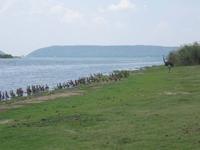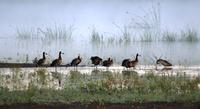Josphine Mundava
Last update: 4 August 2016
Summary
Recent outbreaks of avian influenza in poultry, humans and wild birds have caused a lot of concern.
Given the potential impacts on both humans, and birds, it is important that the dynamics of avian influenza viruses (AIVs) are assessed at a global scale, and that similarities and differences among potential transmission pathways in different regions are considered. Outbreaks of highly pathogenic avian influenza (HPAI) of the subtype H5N1 (commonly known as bird flu) in 2005/6 in Asia, Middle East, Europe and Africa has put an increased focus on the role of wild birds in the persistence of influenza viruses. Waterbirds, particularly Anatidae family, are natural reservoirs of low pathogenic avian influenza (LPAI) and have been implicated as a primary source of infection in HPAI outbreaks. Since the isolation of the first avian influenza viral strains, a number of questions relating to their persistence in ecosystems and the transmission mode among wild and domestic birds and mammals have appeared. Research targeted at answering these questions has shown that knowledge of the ecology of the host species is important in understanding the introduction, maintenance and spread of avian influenza viruses. Although wild birds have been known to play a role in the introduction, maintenance and spread of H5N1, it should be stressed that detailed knowledge of the way(s) in which this takes place is still lacking. Although Zimbabwe has had no records of H5N1 in either wild birds or domestic birds, LPAIs have however been isolated in some waterbird species such as Red-billed Teal and White-faced Duck in the wild. Further surveillance should therefore be targeted at the species that are most likely to carry the virus (LPAIs) as well as seasonal variations in virus prevalence in relation to waterbird abundances. Surveillance should also be targeted at juveniles to determine their role in the maintenance of the virus as they are immunologically naïve and vulnerable to higher rates of infections. The risk of the introduction of new/foreign subtypes of LPAI (which can potentially mutate to HPAI) into the system by migrant waders/shorebirds should also be evaluated.
In this project, the central hypothesis is that AIV prevalence may fluctuate seasonally and circulate all year round due to a variety of factors.
These factors are hypothesised to be abiotic (season, rainfall, lake level) and ecological (species type, guilds) and the number of juveniles in time.The global objective is to increase knowledge on the prevalence of avian influenza in wild birds with reference to host ecology.
Last update: 4 August 2016


